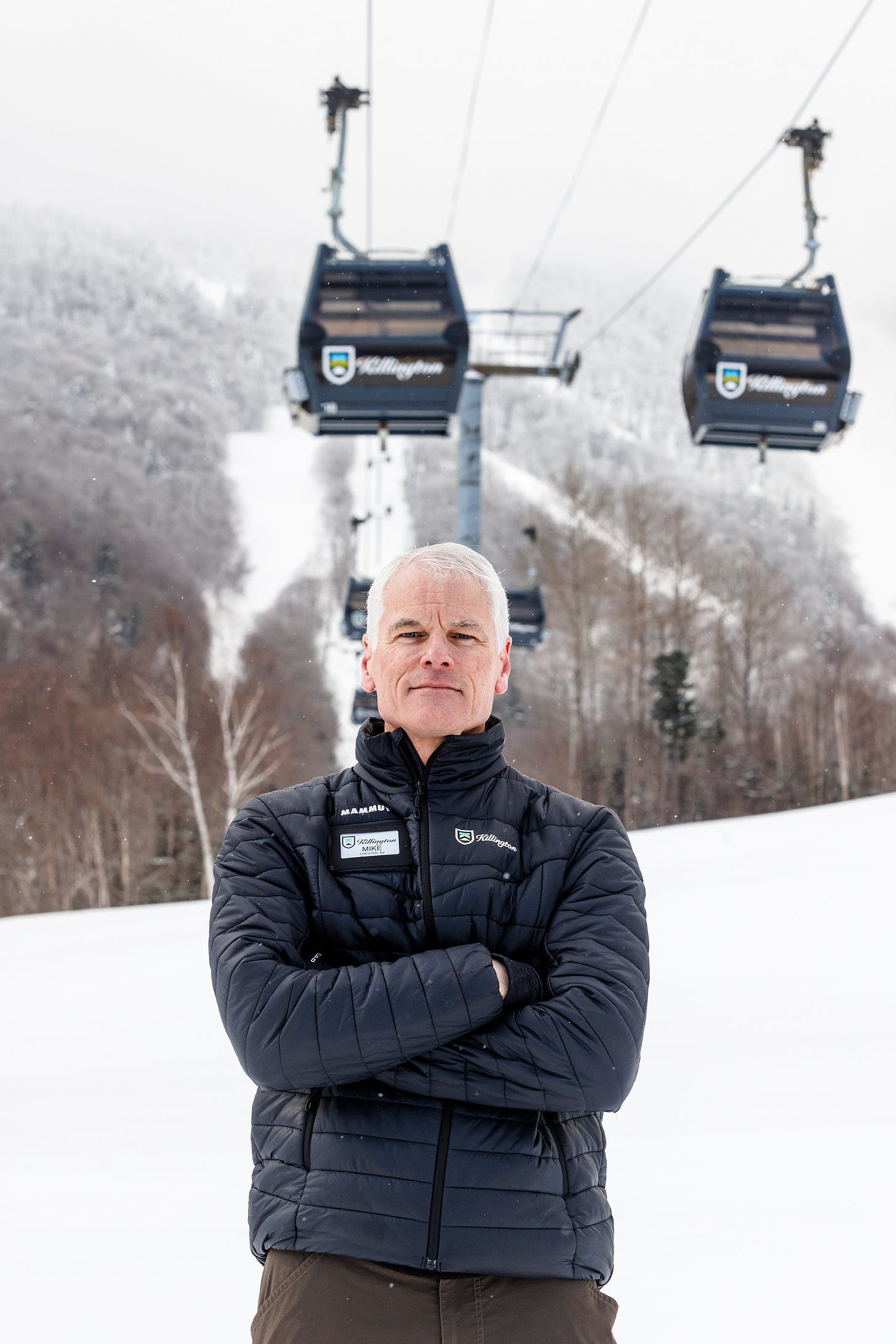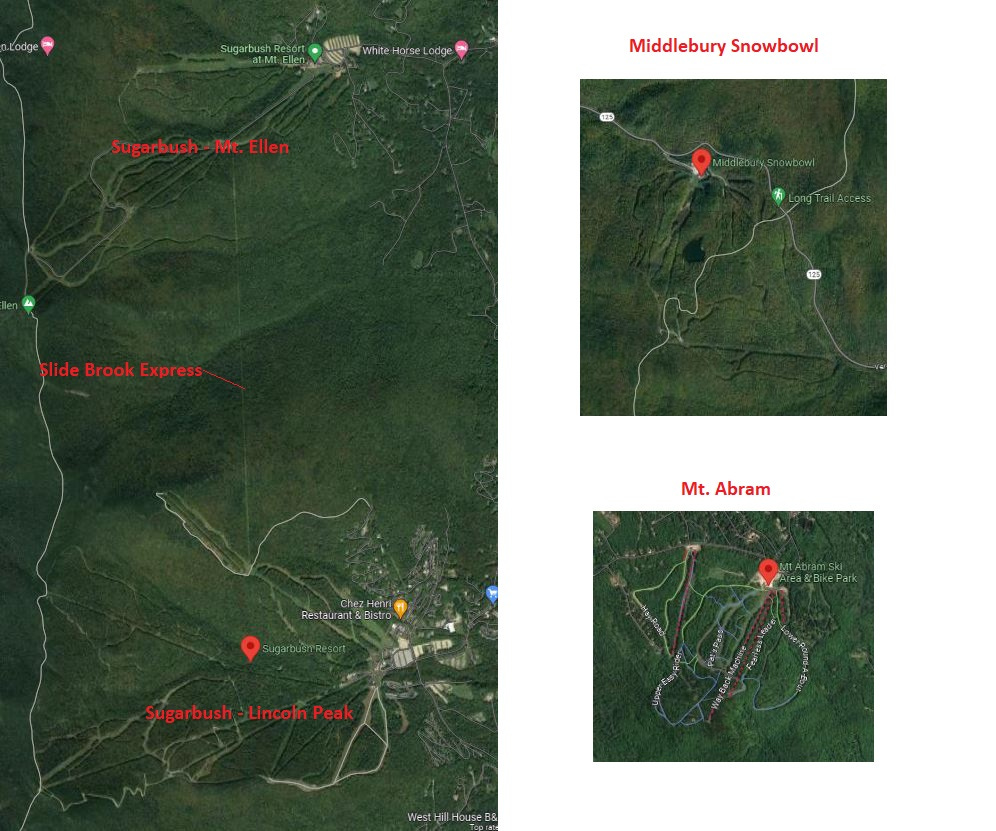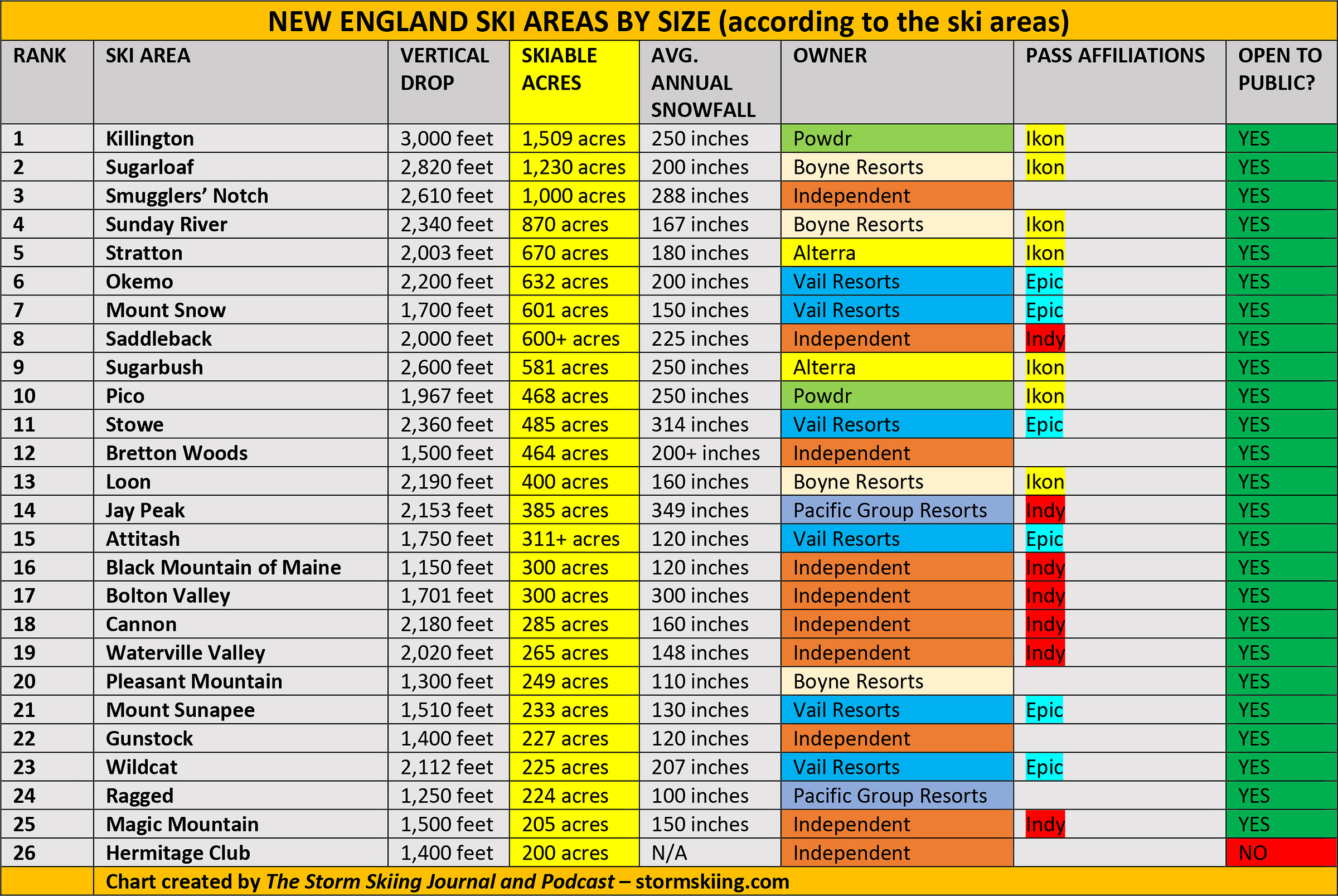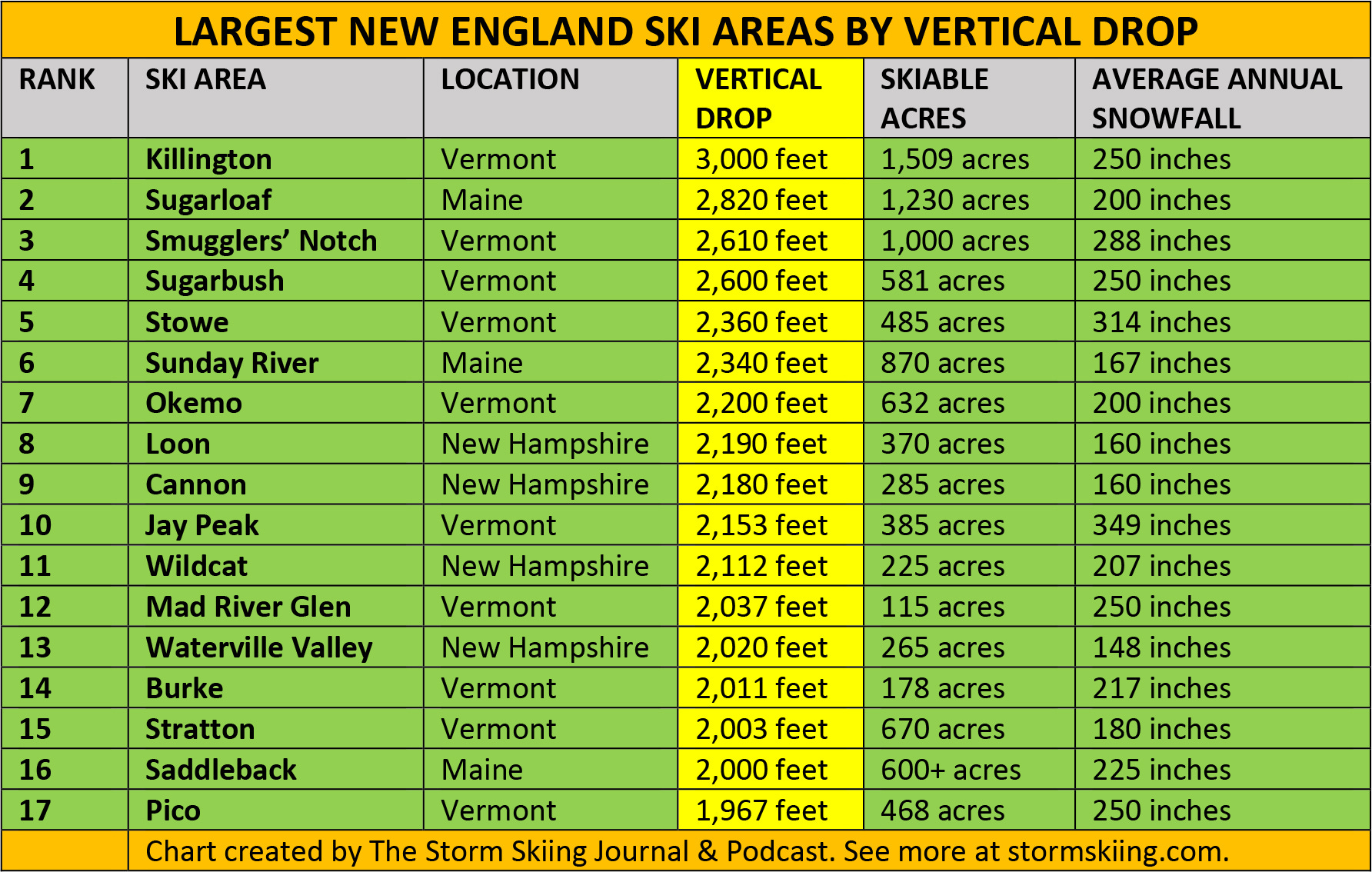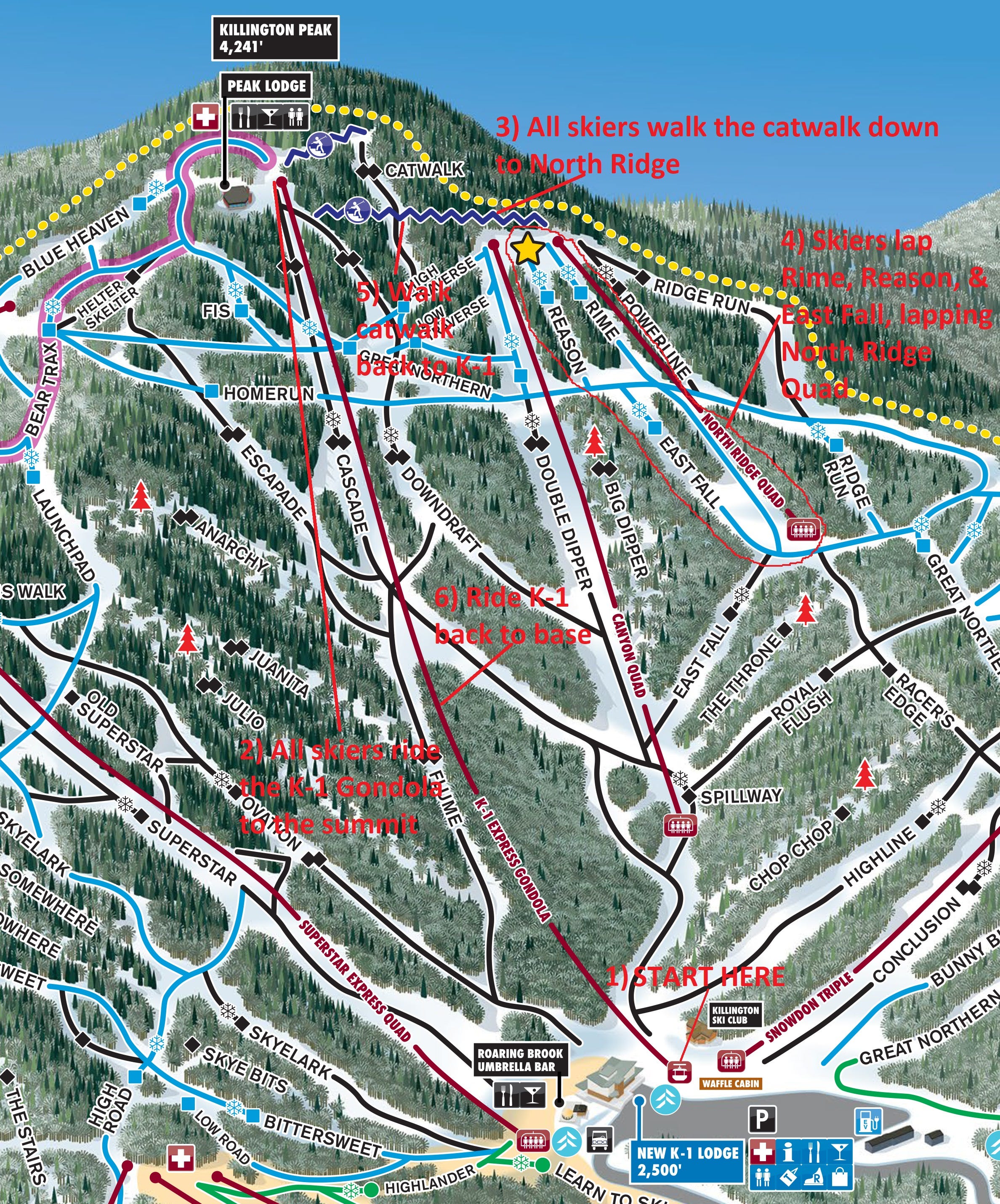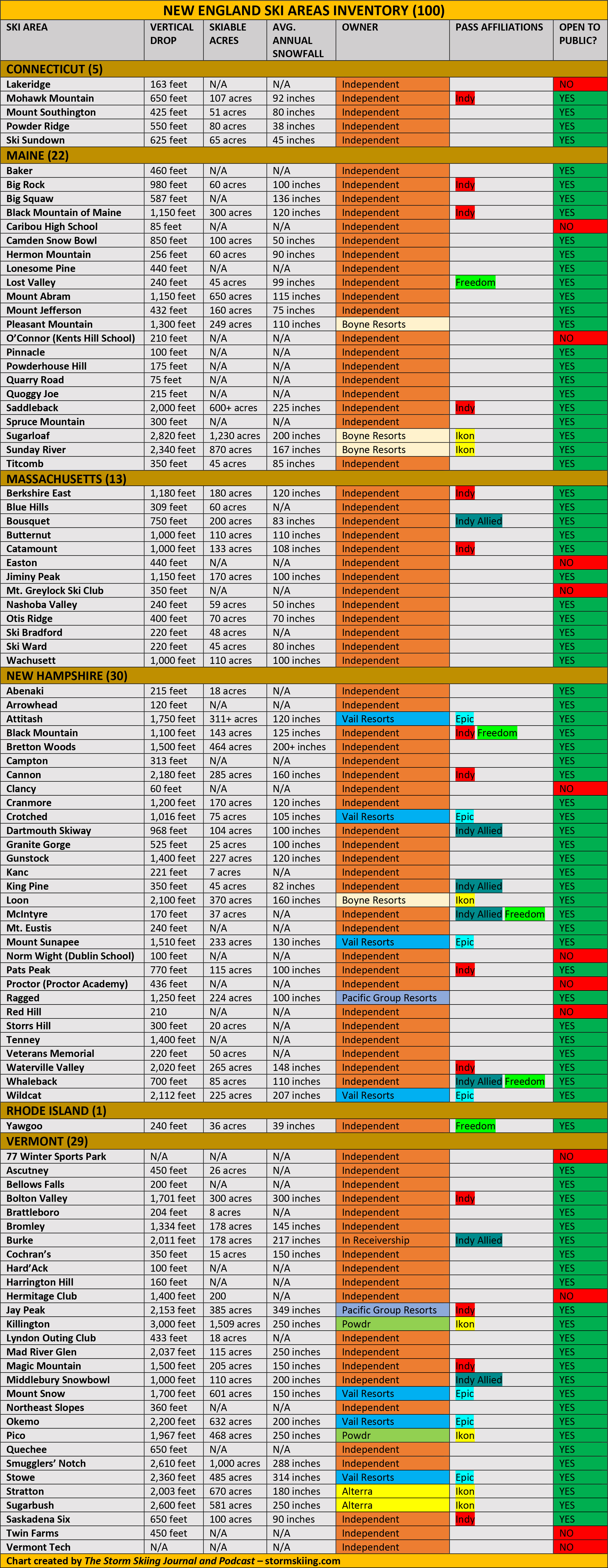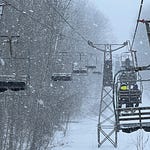Who
Mike Solimano, President and General Manager of Killington and Pico Mountains, Vermont
Recorded on
Sept. 5, 2023
About Killington
Click here for a mountain stats overview
Owned by: Powdr Corp
Located in: Killington, Vermont
Year founded: 1958
Pass affiliations: Ikon Pass: 5 or 7 combined days with Pico
Reciprocal partners: Pico access is included on all Killington passes
Closest neighboring ski areas: Pico (:12), Saskadena Six (:39), Okemo (:40), Twin Farms (:42), Quechee (:44), Ascutney (:55), Storrs (:59), Harrington Hill (:59), Magic (1:00), Whaleback (1:02), Sugarbush (1:04), Bromley (1:04), Middlebury Snowbowl (1:08), Arrowhead (1:10), Mad River Glen (1:11)
Base elevation: 1,156 feet at Skyeship Base
Summit elevation: 4,241 feet at Killington Peak
Vertical drop: 3,085 feet
Skiable Acres: 1,509
Average annual snowfall: 250 inches
Trail count: 155 (43% advanced/expert, 40% intermediate, 17% beginner)
Lift count: 20 (2 gondolas, 1 six-pack, 5 high-speed quads, 5 fixed-grip quads, 2 triples, 1 double, 1 platter, 3 carpets - view Lift Blog’s inventory of Killington’s lift fleet)

About Pico
Click here for a mountain stats overview
Owned by: Powdr Corp
Located in: Mendon, Vermont
Year founded: 1934
Pass affiliations: Ikon Pass: 5 or 7 combined days with Killington
Reciprocal partners: Pico access is included on all Killington passes; four days Killington access included on Pico K.A. Pass
Closest neighboring ski areas: Killington (:12), Saskadena Six (:38), Okemo (:38), Twin Farms (:38), Quechee (:42), Ascutney (:53), Storrs (:57), Harrington Hill (:55), Magic (:58), Whaleback (1:00), Sugarbush (1:01), Bromley (1:00), Middlebury Snowbowl (1:01), Mad River Glen (1:07), Arrowhead (1:09)
Base elevation: 2,000 feet
Summit elevation: 3,967 feet
Vertical drop: 1,967 feet
Skiable Acres: 468
Average annual snowfall: 250 inches
Trail count: 58 (36% advanced/expert, 46% intermediate, 18% beginner)
Lift count: 7 (2 high-speed quads, 2 triples, 2 doubles, 1 carpet - view Lift Blog’s inventory of Pico’s lift fleet)

Why I interviewed him
Imagine if the statistical bureaus of nations operated like ski areas - the countries just threw around numbers with no basis in measurable reality. China could say it was bigger than Russia, U.S. America could claim more territory than Canada, and North Korea could say it was bigger than all of them combined (hell, it probably does).
This is the world one steps into when trying to ascertain the size of New England ski areas. Mt. Abram claims 450 acres. Middlebury Snow Bowl brags on “600-plus acres of woods and glades,” which would make it larger than Sugarbush, the Alterra-owned mega-resort that undersells itself with a 581-acre tally. Here’s what the aliens would see if they were to match our internet boasts up to measurable reality:
Did Middlebury Snowbowl acquire the air rights over its mountain? Is Mt. Abram built like Istanbul, with several ancient ski areas buried beneath the modern foundation, giving us a vast ski labyrinth to explore?
This strategy probably worked better when most skiers’ mode of resort comparison was “scanning a bunch of brochures at a rest area.” It’s harder to maintain when every human carries a device equipped with a map of planet earth in their pocket at all times. But ski areas keep fibbing anyway.
Which is probably why, several years ago, Killington started measuring itself like a Western ski area: draw a border around the property – that’s your skiable terrain. Oh, and we’ll no longer yell at you for skiing in the woods, which is technically “terrain” even if the underbrush is too thick for anything larger than a chipmunk to navigate.
Some of you would like me to challenge statistical inconsistency across the ski industry as a main feature of this newsletter. But I prefer to just make fun of it. If Mt. Abram wants to be the Baghdad Bob of New England skiing, well, what else are you going to do for attention when you’re across the street from Sunday River, whose annual lift-upgrade budget exceeds the GDP of Australia?
But until the North Conway Treaty of 2038, at which the ski areas of North America will collectively agree upon a universal statistical standard based upon actual measurements, I’m just going to take their word for it (sort of). Here’s a list of New England ski areas from largest to smallest, by skiable acreage, according to the ski resort’s own claims (I excluded Middlebury Snowbowl and Mt. Abram, which more accurately measure out at 110 and 170 acres, respectively):
Anyone who’s spent any amount of time skiing New England knows that something feels off with this list. Sugarbush, Stowe, and Jay – three of the dozen or so New England ski areas with reliable glades – ski as big as anything in the East. All three feel substantively larger than Stratton or Mount Snow. And neither Bolton Valley nor Black Mountain of Maine ski on the scale of Cannon or Waterville Valley.
But no one is disputing that top line. Killington is the largest ski area in New England. You can quibble about the vertical drop – the gut of Killington is the 1,650-ish-foot K-1 face. To scoop up the full 3,000-plus feet requires a rarely-skied meander down to the Skyeship Base at US 4. Mt. Ellen at Sugarbush (2,600 vertical feet), Madonna at Smuggs (2,150), FourRunner at Stowe (2,046), the single chair at Mad River Glen (1,972 feet), and Sugarloaf’s spectacular 2,820-foot face all deliver more sustained steep skiing than The Beast.
But there’s nothing else in the East on Killington’s scale, the massive overlapping network of six peaks rolling in all directions from the frantic hub. It’s one of the few ski areas, East or West, where I ever truly feel lost. There’s something brilliantly scattershot about it, something feral and boundless and enigmatic, as though 16 small ski areas had been stapled together by someone who’s never skied. There are insane traverses and endless flats, riotously steep trees and bumps all over, long groomers that you think lead back to the same lift you just exited, but instead seem to deposit you in New Hampshire. There are trails on the far fringe that feel abandoned on even the busiest days, where you suspect without being able to prove it that you’ve been transported to an alternate dimension of groomed forever-down, or at least back to a time before the Ikon Pass gave every skier on the eastern seaboard an annual allotment of Killington lift tickets.
It all works somehow. This great machine, howling like an armor-plated Mad Max rig, a cobbled-together war machine screaming across the winter plains. It feels like it should fall apart, disintegrate by the combined forces of speed and volume. But it carries on, the growling, supercharged id of New England winter, The Beast a gloss well-earned.
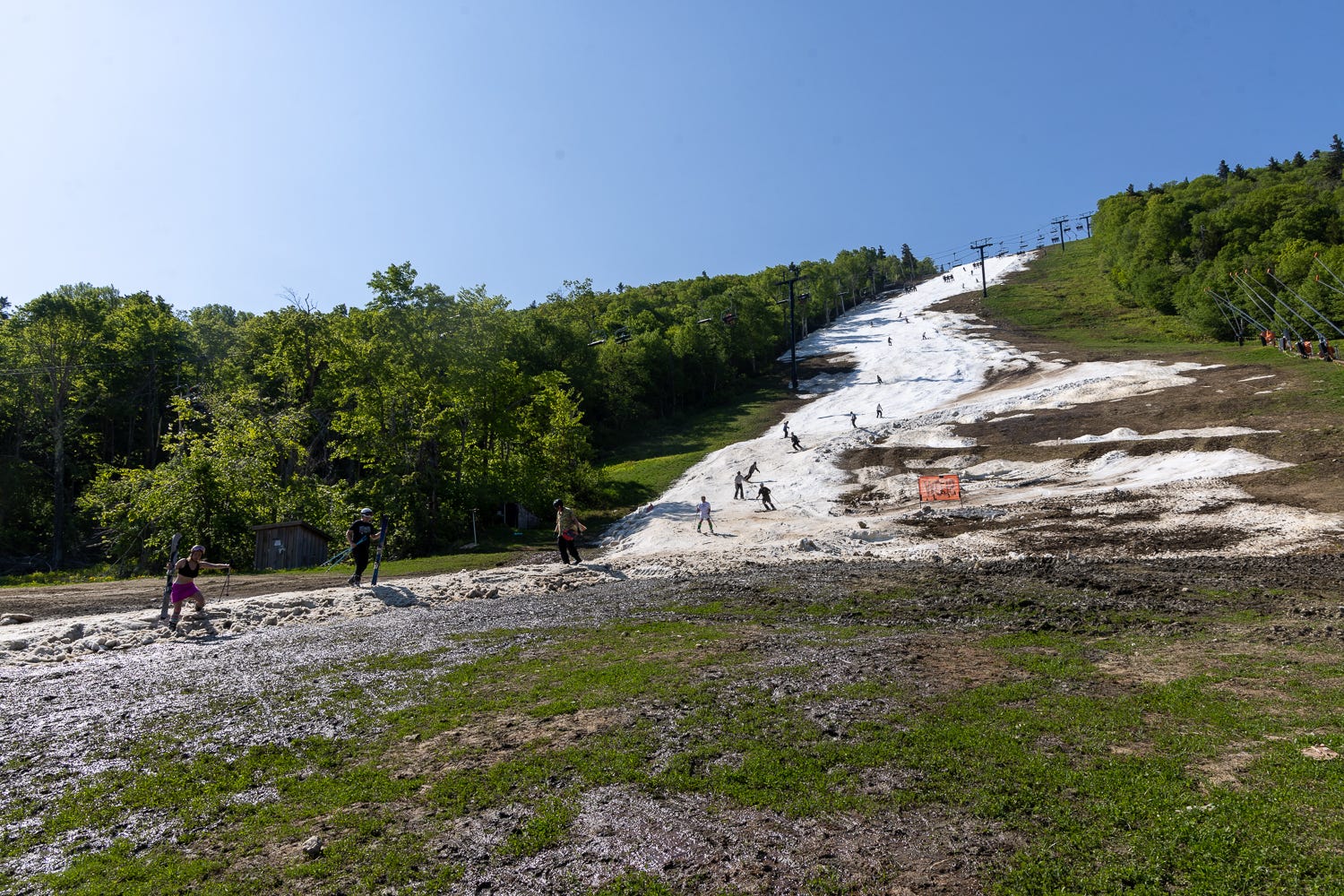
What we talked about
What’s behind Killington’s run of June closings; building the Superstar Glacier; why “The Beast” returned; how Killington pulled off the 2022 World Cup with a wildly warm November; what happened to October openings; early- versus late-season energy; whether social media makes the spring skiing party seem bigger than it is; Pico’s massive, multi-year snowmaking evolution; “Pico’s probably not worth what one detachable lift costs on its own” – the hard math of lift upgrades; Powdr Corp’s long-term commitment to Pico; Pico’s private mid-week mountain rentals; the new K-1 lodge; falling in love with skiing on a Magic Mountain powder day; when you start as chief financial officer and the parent company informs you that they may not be able to make payroll the following month; Killington’s rowdy transition from American Skiing Company to Powdr Corp to present-day calm; why Powdr Corp had such a tough time adapting to New England, and how the company finally did; online absurdities; the evolution of Powdr Corp; a Killington base village, on the way at last; why the village took so long to permit; “to be a successful village, it can’t just be a bunch of condos”; putting pedestrians first; what the village will mean for parking at Ramshead, Snowshed, Vale, and K-1; employee housing; how the village will connect to the resort’s lift system; whether we could see a lift from the village up to K-1; why Killington hasn’t upgraded Snowshed yet; redesigning Killington Road; fixing Killington’s water-quality issues; considering mass transit along Killington Road; priorities for lift upgrades at both ski areas; where Killington could install another six-pack; whether future sixers would have bubbles or D-line tech; why eight-pack lifts are unlikely; the potential for upgrades for the Bear Mountain quad and Snowden triple; what could eventually replace Outpost at Pico; current thinking around the Killington-Pico Interconnect; Fast Tracks two years in; Fast Tracks season passes; the Beast 365 and Ikon Base Pass add-on; and whether Beast 365 passholders are complaining about the dilution of the Ikon Base Pass (spoiler alert: they are).
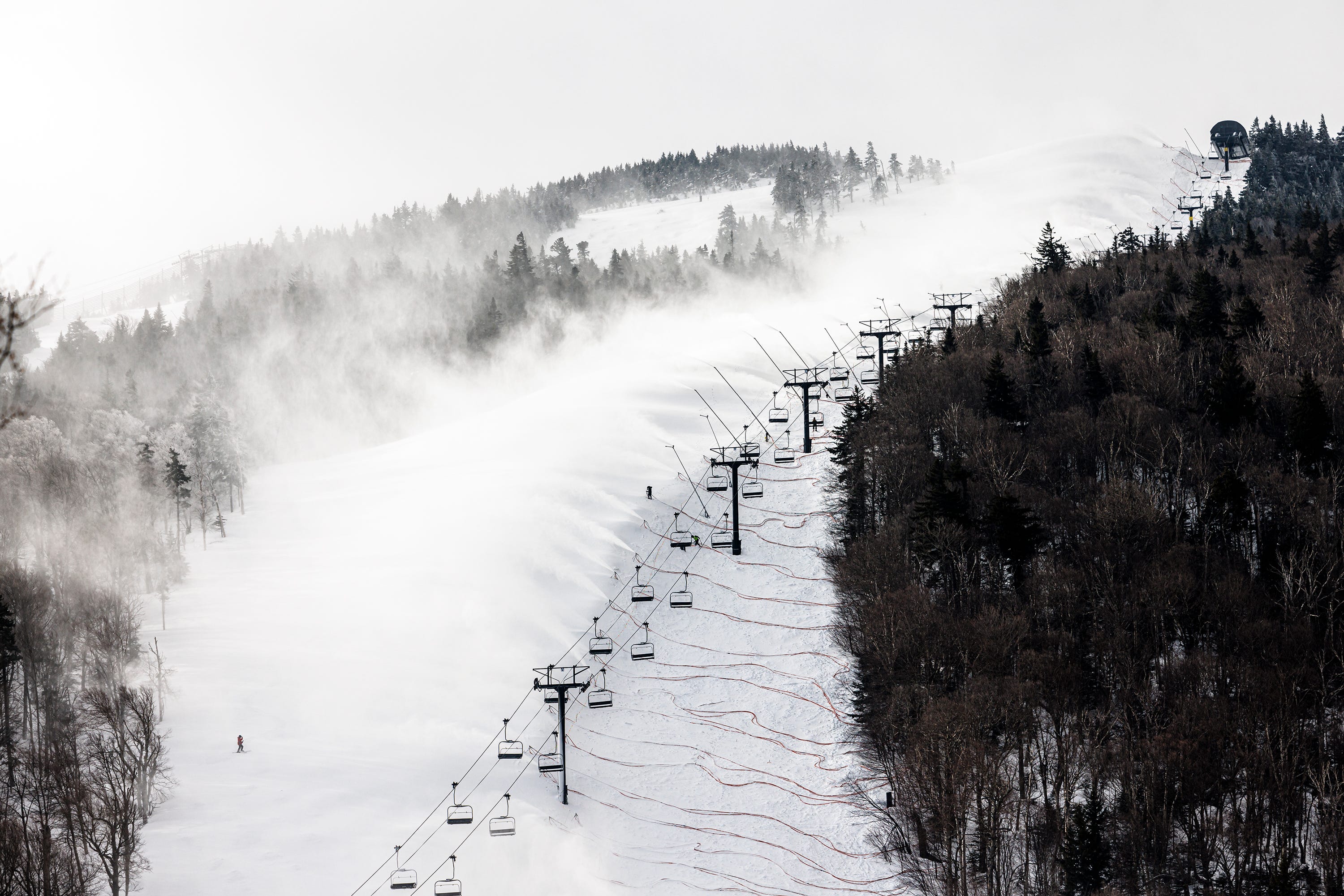
Why I thought that now was a good time for this interview
Storm Skiing Podcast #1: Killington & Pico President & General Manager Mike Solimano, was not the first episode I ever recorded, but it was the first one I released. Because, as I wrote at the time, “if you’re going to start something like a podcast about Northeast skiing, you really ought to lead off with the most punch-you-in-your-face prominent part of Northeast skiing.” Starting this series with the head of the largest and baddest ski resort in New England injected The Storm with an instant patina of legitimacy, a forked road into journalism from the speculating, self-assured masses endlessly debating ski areas on social media.
There are hazards, of course, to going first, especially for a rapidly evolving brand like The Storm. A lot has changed in four years. The podcast sounds better. The Storm’s scope has expanded nationwide, embedding each subject in a national, rather than a regional, context. The article accompanying each episode is far richer, with maps and stats and charts that the reader once had to source on their own. And I hope – I’ll let the listener decide – that I’ve improved as an interviewer and as a host.
It was time to reset Killington and Pico. But with purpose. My mission, at The Storm’s outset four years ago, was simply to make connections with ski area leaders. The podcast episodes were more general-information sessions than conversations tuned to the moment. But almost every podcast on the current schedule is pegged to some tangible development: Keystone (scheduled for the week of Sept. 11), is opening the Bergman Bowl expansion after a one-year delay; Snowbird (Sept. 18), is a big player in the controversial Little Cottonwood Canyon gondola project; Attitash (Nov. 6), is at long last replacing the Summit Triple with a high-speed quad. Even Great Bear, South Dakota – scheduled for the week of Sept. 25 – is planning a new lift and expansion.
Killington just announced what is potentially the most transformative project in New England skiing for at least a generation: the approval to build, at long last, a (hopefully pedestrian) base village in the vast basin between Snowshed and Ramshead, a space currently occupied by parking lots sizeable enough to house the population of Ecuador. The East does not currently have anything like this – at least not at the foot of a ski area, where such things ought to be. But the region desperately needs this sort of human-scaled infrastructure.
I live in New York City, which means I am surrounded by acquaintances who have the means and desire to ski, but who do not necessarily ski that often. They will frequently petition me for recommendations that sound something like: where can I take my family/group of friends/brunch club skiing for a long weekend that is within driving distance of the city, has somewhere to stay on the mountain, and has food/drinking options within a short walk? And my answer to them is: there is nothing like that here. Go to Park City/Breckenridge/Aspen/somewhere else out West. New England is so preoccupied with preserving their natural environment that most meaningful development is done a several-mile drive from the major ski hills, which of course compromises the natural environment with sprawl, excessive traffic, and parking lots the size of the Mendenhall Glacier.
There are some minor exceptions to this: small villages at Stratton and Stowe. Ample slopeside accommodations at Smugglers’ Notch and Okemo. But none of these give the skier that sense of place they’ll find in Steamboat or Crested Butte or even Vail Village, with its pedestrian walkways paved over what had been wilderness until the 1960s. But who says a new village is a “fake” village, as they’re so often framed? A place for people to gather is a place for people to gather, and if we could build such places 2,000 years ago, we can build them today.
New England deserves this. Because great ski areas are better when the community doesn’t end at the bottom of the lift queue. Because once we build one, others will follow. Because it’s a fairly stupid fact that the region of the United States most known for its quaint small towns is without a single quaint ski town (meaning, one that backs up to the ski resort). Because Built America has sprawled out enough, and its time to back up and fill in all the blank space with something better. Because there is no better way for a state preoccupied with preserving its natural environment to build than in dense clusters of life and activity. And because it would be fabulous and because it would work and because I’m tired of telling New Yorkers to fly to Aspen when Killington ought to be able to give them everything they need.
Questions I wish I’d asked
I wanted to talk a bit about the Woodward park that Powdr has been dropping at Killington each of the past several winters. I also had a few questions about passes: the Pico K.A.’s odd name, the creeping price of the Killington spring pass, whether the Mountain Collective was in play for Killington.
What I got wrong
About the size of Pico
I said Pico was about “the size of Cannon or the size of Waterville Valley.” This is kind of true but was also an on-the-fly guess. As is clear from the skiable acreage discussion above, gauging the size of New England ski areas is a little bit of a party game. I think Pico and Waterville are about the same size, but Pico, mimicking Killington’s border-to-border measurement philosophy, claims 468 acres. Waterville, which, according to general manager Tim Smith, only counts trail acreage, sits at 265 acres. But both hit right around 2,000 feet of vert. Cannon is a bit higher, at 2,180. Still, I think it was a fair comparison. Here are New England’s tallest ski areas, organized by vertical drop:
About resumes
I said in the intro that Solimano had joined Killington in 2002. He actually started in December 2001, as he clarifies in the interview.
About the Ikon Base Pass
When discussing the erosion of the Ikon Base Pass over time, I said that “Alterra had taken mountains off” the pass. That wasn’t exactly right or fair. Former Alterra CEO Rusty Gregory told me on the podcast last year that Alterra resisted creating the Plus tier for Ikon Base. But Jackson Hole and Aspen, facing locals’ revolts over the pass’ impact, insisted on doing something. The Ikon Base Plus, then, was a compromise. Other ski areas have followed since the Base Plus debuted in 2020: Alta and Deer Valley (the latter of which Alterra does own) in 2022, and Taos in 2023. Snowbasin and Sun Valley opted for Base Plus over Base when they joined the coalition in 2022.
Still, however we got here, the fact is this: the Ikon Base Pass excludes seven of the pass’ most attractive destinations. Unfortunately, passholders at partner resorts that offer an Ikon Base Pass with their top-tier season passes (Sugarloaf, Sunday River, Loon, Killington, Windham, Aspen, Big Sky, Taos [sold out], Alta, Snowbasin, Snowbird, Brighton, Jackson Hole [sold out], Sun Valley, Mt. Bachelor, Boyne Mountain), are not able to upgrade to an Ikon Base Plus or full Ikon Pass. Several leaders of the above-mentioned mountains have confirmed to The Storm that their passholders find this annoying, like getting a year of free Domino’s but being told that you can only order salad and sandwiches. No pizza for you.
Alta is the pizza on the Ikon Pass. Jackson Hole is pizza. Aspen is pizza. Blue Mountain is a Chicken Ceasar salad. It’s nice. It tastes fine. But really everyone wants the pizza.
Here’s that chart again tracking Ikon Pass partners by tier over time:
Why you should ski Killington and Pico
One reason to ski Killington is easy: often, it’s your only option. The mountain closed June 1 this year, more than a month after every other resort in the region other than Jay and Sugarbush, which both ran to May 7. On the other end, The Beast has somewhat ceded its rush to open. After six October openings in the eight seasons beginning in 2011, Killington hasn’t spun the lifts before Halloween since 2018 (warm falls and Covid haven’t helped). But they’re rarely beaten to go-live in New England, and seasons that push or exceed 200 days make sure the mountain’s expensive season pass is worth it.
Pico is funny. If it were anywhere else other than exactly next door to the largest ski area in New England, Pico might be a major ski area. Its 468 acres would make it the largest ski area in New Hampshire. A 2,000-foot vertical drop is impressive anywhere. The mountain has two high-speed lifts. And, by the way, knockout terrain. There is only one place in the Killington complex where you can run 2,000 vertical feet of steep terrain: Pico.
The American norm is that skier visits move east-to-west. But I’ll get an occasional email from a Rocky Mountain dweller who’s visiting family out east, and they want to know where to ski. There are 100 ski areas in New England – more than in Colorado (34), California (30), Utah (18), and Montana (16) combined. How do you sort through all that? If you want my recommendations of what to do with a week, I’d tell you to start with Killington, then move north through Sugarbush, Mad River Glen, Stowe, Smugglers’ Notch, and Jay Peak. Then cross the top of New England to Sugarloaf. That’s the best of what we’ve got. But The Beast, the king of them all, is Killington.
Podcast Notes
Miscellany on items discussed in the podcast:
On Killington’s historic opening and closing dates
Killington has done a nice job documenting these on its website:
On the history of the Women’s World Cup at Killington
Since 2016, Killington has acted as the early-season U.S. stop on the Women’s World Cup, drawing enormous, raucous crowds. While I don’t cover ski racing or competition, I acknowledge the importance of this event to Killington, as an ancillary business, as a celebration of the sport, as a cultural token, and as a showcase of the resort’s singular snowmaking firepower. You can sign up for Killington’s World Cup updates here.
On North Ridge early-season skiing
Early-season skiing at Killington is a novel, inventive, highly orchestrated event. Typically, only three runs are open, and they are lodged on an area called North Ridge near the top of Killington Peak. Skiers park in the K-1 lot, ride the K-1 gondola over brown slopes to the summit, walk across a catwalk (and its many, many steps), and arrive in winter: typically the Rime, Reasons, and East Fall trails, snowy and frantic with fellow early-season lunatics. The concentration of very good skiers tends to be quite amazing, as the Park Brahs are Parking Out Brah – with whatever little knoll they can turn into a feature (plus, usually, a few built on Reason by Killington’s parks crew). You lap North Ridge Quad for as long as you can tolerate, but you can’t ski back down – there’s no snow below East Fall. So you have to hike back up the catwalk, back to K-1, and ride the gondy back down to the parking lot. Here’s a diagram:
It’s less about the skiing, frankly, than about being a part of something unique and joyful. The skiing, however, is sometimes quite good, especially if it’s cold enough to leave the snowguns running, refreshing the surface all day long.
On Pico’s lift fleet
Pico has one of the oldest lift fleets in New England – the last new lift install was 35 years ago. Strangely, the mountain also has two high-speed quads, both the (historically) problematic Yan detachables (read more on that in the Podcast Notes section here). But, for reasons Solimano details in the podcast, new lifts are unlikely anytime soon. Pico’s current state, per Lift Blog:
On Powdr Corp’s portfolio
Killington is one of 10 North American ski areas owned by Park City-based Powdr Corp:
On the lawsuit around lifetime season passes
When Powdr Corp purchased Killington in 2007, the company inherited the largest ski area in New England – and a gigantic anchor in the form of 1,243 “lifetime” season passes distributed by a former owner. Powdr said, “Yeah we’re not doing that,” the passholders sued, and Powdr ultimately won. A 2010 synopsis from Legal Blog Watch:
Twenty years ago, Killington, Vt., resident Martin Post and his wife, Jill, paid about $3,500 each for lifetime ski passes at Killington Resort. The Posts are happily still alive but, as of May 17, 2010, their passes are not.
The Times Argus reports that in May, U.S. Judge Christina Reiss found that the resort's current owners, SP Land Co. and Powdr Corp., which purchased Killington Resort in 2007, were under no legal obligation to honor the passes that were sold in the early years of the ski area as an incentive to attract investors.
The class action litigation before Judge Reiss involved 1,243 pass holders -- 342 yearly transferable passes and 901 passes that could be transferred a single time. The plaintiffs alleged that under the wording of the investor passes, the holder is entitled "to the free use of all ski lifts operated by (Sherburne) Killington Ltd. at (Killington Basin) Killington Ski Area so long as the corporation shall operate in that area under an agreement with the state of Vermont." Plaintiffs claimed that the reference to "the corporation" meant any subsequent operator of the ski area, including the new owners, but the court disagreed.
Judge Reiss granted the defendants' motion for summary judgment, finding that "the only reasonable interpretation of that language is that it requires Killington Ltd. to provide the designated passholder free use of all ski lifts operated by Killington Ltd. at the Killington Ski Area so long as it operates in that area ... "The term corporation, she wrote, "clearly refers to the named corporations, Sherburne and Killington Ltd." and "reveals no intention to bind Killington Ltd's successors ... To the contrary, Killington Ltd.'s obligations under the passes clearly terminate with its cessation of operations in the area."
The plaintiffs have appealed Reiss' decision to the 2nd U.S. Circuit Court of Appeals.
I’m assuming the plaintiffs lost the appeal, but I can’t find any record of it.
On New England’s 100 ski areas
Here’s the inventory - collect them all! (let me know if you have):
The Storm publishes year-round, and guarantees 100 articles per year. This is article 74/100 in 2023, and number 460 since launching on Oct. 13, 2019. Want to send feedback? Reply to this email and I will answer (unless you sound insane, or, more likely, I just get busy). You can also email skiing@substack.com.



